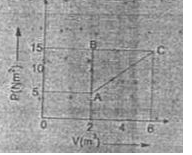1g mole of an ideal gas at STP is subjected to a reversible adiabatic expansion to double its volume. Find the change in internal energy (γ=1.4)
1169.5J
769.5J
1369.5J
969.5J
The correct Answer is:C
To solve the problem of finding the change in internal energy of 1 g mole of an ideal gas undergoing a reversible adiabatic expansion to double its volume, we can follow these steps:
Step 1: Understand the given information
- We have 1 g mole of an ideal gas.
- The process is a reversible adiabatic expansion.
- The initial conditions are at Standard Temperature and Pressure (STP), which means:
- T1=273K
- P1=1atm
- V1=22.4L (for 1 mole of gas at STP)
- The final volume V2=2V1.
Step 2: Apply the adiabatic condition
For an adiabatic process, we can use the relation:
T1Vγ−11=T2Vγ−12
Where γ=1.4.
Step 3: Substitute the values
Substituting V2=2V1 into the equation:
T1Vγ−11=T2(2V1)γ−1
This simplifies to:
T1=T2⋅2γ−1
Step 4: Solve for T2
Rearranging gives:
T2=T12γ−1
Substituting T1=273K and γ=1.4:
T2=27320.4
Step 5: Calculate 20.4
Calculating 20.4:
20.4≈1.319
Thus:
T2≈2731.319≈206.6K
Step 6: Calculate the change in internal energy
The change in internal energy for an ideal gas during an adiabatic process is given by:
ΔU=nCv(T2−T1)
Where Cv=Rγ−1.
For 1 mole of gas:
Cv=8.311.4−1=8.310.4=20.775J/K
Step 7: Substitute values into the change in internal energy equation
Now substituting n=1, Cv, T1, and T2:
ΔU=1×20.775×(206.6−273)
Calculating (206.6−273)=−66.4:
ΔU=20.775×(−66.4)≈−1379.5J
Final Answer
The change in internal energy ΔU is approximately:
ΔU≈−1379.5J
- We have 1 g mole of an ideal gas.
- The process is a reversible adiabatic expansion.
- The initial conditions are at Standard Temperature and Pressure (STP), which means:
- T1=273K
- P1=1atm
- V1=22.4L (for 1 mole of gas at STP)
- The final volume V2=2V1.
For an adiabatic process, we can use the relation:
T1Vγ−11=T2Vγ−12
Where γ=1.4.
Substituting V2=2V1 into the equation:
T1Vγ−11=T2(2V1)γ−1
This simplifies to:
T1=T2⋅2γ−1
Rearranging gives:
T2=T12γ−1
Substituting T1=273K and γ=1.4:
T2=27320.4
Calculating 20.4:
20.4≈1.319
Thus:
T2≈2731.319≈206.6K
The change in internal energy for an ideal gas during an adiabatic process is given by:
ΔU=nCv(T2−T1)
Where Cv=Rγ−1.
Cv=8.311.4−1=8.310.4=20.775J/K
Now substituting n=1, Cv, T1, and T2:
ΔU=1×20.775×(206.6−273)
Calculating (206.6−273)=−66.4:
ΔU=20.775×(−66.4)≈−1379.5J
The change in internal energy ΔU is approximately:
ΔU≈−1379.5J
Topper's Solved these Questions
- KINETIC THEORY OF GASES AND THERMODYNAMICSBOOK - A2ZCHAPTER - KINETIC THEORY OF GASES AND THERMODYNAMICSEXERCISE - Application Of First Law Of Thermodynamics In Different Situations
25 Videos
- KINETIC THEORY OF GASES AND THERMODYNAMICSBOOK - A2ZCHAPTER - KINETIC THEORY OF GASES AND THERMODYNAMICSEXERCISE - Second Law Of Thermodynamics
29 Videos
- KINETIC THEORY OF GASES AND THERMODYNAMICSBOOK - A2ZCHAPTER - KINETIC THEORY OF GASES AND THERMODYNAMICSEXERCISE - Ideal Gas Equation
32 Videos
- GRAVITATIONBOOK - A2ZCHAPTER - GRAVITATIONEXERCISE - Chapter Test
29 Videos
- MOCK TESTBOOK - A2ZCHAPTER - MOCK TESTEXERCISE - Motion With Constant Acceleration
15 Videos
Similar Questions
Knowledge Check
One mole of an ideal gas at 25∘C is subjected to expand reversible ten times of its intial volume. The change in entropy of expansion is
A19.15JK−1mol−1B16.15JK−1mol−1C22.15JK−1mol−1DNone1 mole of an ideal gas at 25∘ C is subjected to expand reversibly and adiabatically to ten times of its initial volume. Calculate the change in entropy during expansion (in JK−1mol−1)
A19.15B−19.15C4.7DzeroThe volume of an ideal diatomic gas is doubled isothermally. The internal energy
Ais doubledBis halvedCis increases four timesDis remains unchanged
During isothermal expansion of an ideal gas, the change in internal energy is ..............
View SolutionOne mole of an ideal monoatomic gas is taken at a temperature of 300K. Its volume is doubled keeping its pressure constant. Find the change in internal energy.
View SolutionThe given figure shows a change of state A to state C by two paths. ABC and AC for an ideal gas. Calculate the ,

(a) Path along which work done is least.
(b) Internal energy at C if the internal energy of gas at A is 10 J and amount of heat supplied to change its state to C through the path AC is 200 J.
( c) Amount of heat supplied to the gas to gd from A to B, if internal energy of gas at state B is 10 J.
(ii) In an insulated contained 1 mole of a liquid, molar volume 100 mL. is at 1 bar liquid is steeply taken to 100 bar, where volume of liquid decreases by 1 mL. Find ΔE and ΔH for the process?
(iii) 14 g of oxygen at 0∘ C and 10 atm are subjected to reversible adiabatic expansion to a pressure of 1 atm. Calculate the work done in
(i) Litre atm.
(ii) Calorie (Given, CpCv=1.4).
View SolutionThe volume of an ideal diatomic gas is doubled isothermally. The internal energy
View SolutionOne mole of a monoatomic ideal gas was isobarically heated from 300 K to 600 K at constant pressure of one atm. Subsequently, it is subjected to reversible adiabatic expansion till the volume becomes 4√2 of origingl (starting) value. After that it is subjected to isobaric cooling to original volume.
Select the correct statement :
View Solution
